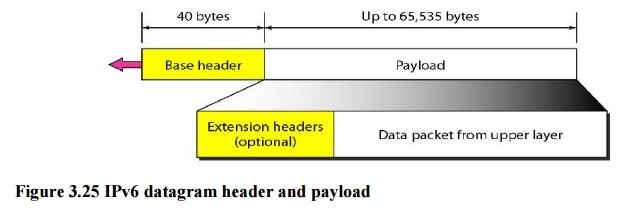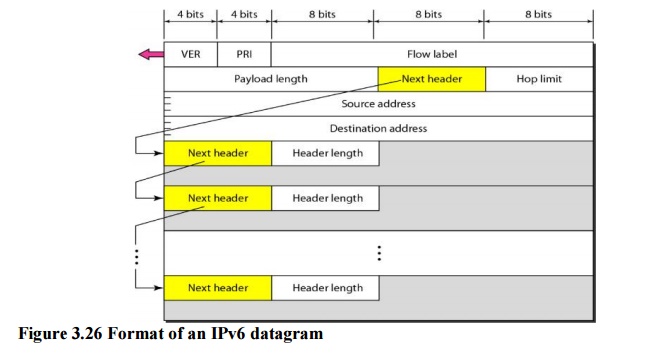Chapter: Computer Networks : Network Layer
IPv6
IPv6:
The
network layer protocol in the TCPIIP protocol suite is currently IPv4
(Internetworking Protocol, version 4). IPv4 provides the host-to-host
communication between systems in the Internet. Although IPv4 is well designed,
data communication has evolved since the inception of IPv4 in the 1970s. IPv4
has some deficiencies that make it unsuitable for the fast-growing Internet.
Despite
all short-term solutions, such as subnetting, classless addressing, and NAT,
address depletion is still a long-term problem in the Internet. The Internet
must accommodate real-time audio and video transmission. This type of
transmission requires minimum delay strategies and reservation of resources not
provided in the IPv4 design.
1. Advantages
The
next-generation IP, or IPv6, has some advantages over IPv4 that can be
summarized as follows:
1.
Larger address space
2.
Better header format
3.
New options
4.
Allowance for extension
5.
Support for resource allocation
6.
Support for more security
2. Packet Format
Each
packet is composed of a mandatory base header followed by the payload. The
payload consists of two parts: optional extension headers and data from an
upper layer. The base header occupies 40 bytes, whereas the extension headers
and data from the upper layer contain up to 65,535 bytes of information.

a. Base Header
These
fields are as follows:
·
Version: This
4-bit field defines the version number of the IP. For IPv6, the value is 6.
·
Priority: The
4-bit priority field defines the priority of the packet with respect totraffic
congestion.
·
Flow
label: The flow label is a 3-byte (24-bit) field that is designed to provide
specialhandling for a particular flow of data.
·
Payload
length: The 2-byte payload length field defines the length of the IP
datagramexcluding the base header.
·
Next
header: The next header is an 8-bit field defining the header that follows
thebase header in the datagram. The next header is either one of the optional
extension headers used by IP or the header of an encapsulated packet such as
UDP or TCP. Each extension header also contains this field.

·
Hop
limit: This 8-bit hop limit field serves the same purpose as the TIL field in
IPv4.
·
Source
address: The source address field is a 16-byte (128-bit) Internet address
thatidentifies the original source of the datagram.
·
Destination
address. The destination address field is a 16-byte (128-bit) Internetaddress
that usually identifies the final destination of the datagram. However, if
source routing is used, this field contains the address of the next router.
·
Priority:
The
priority field of the IPv6 packet defines the priority of each packet
withrespect to other packets from the same source. For example, if one of two
consecutive datagrams must be discarded due to congestion, the datagram with
the lower packet priority will be discarded. IPv6 divides traffic into two
broad categories: congestion-controlled and noncongestion-controlled.
Related Topics